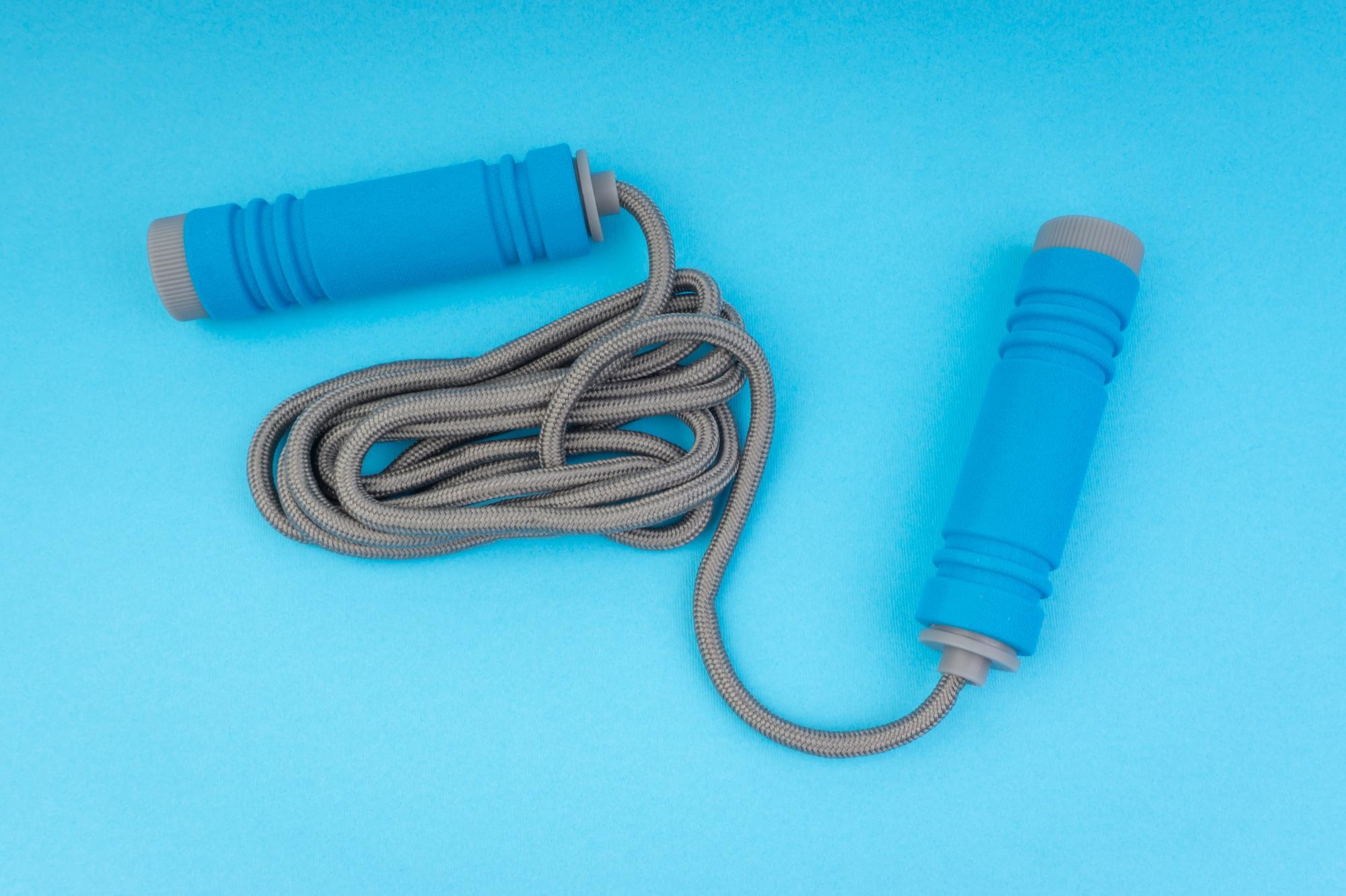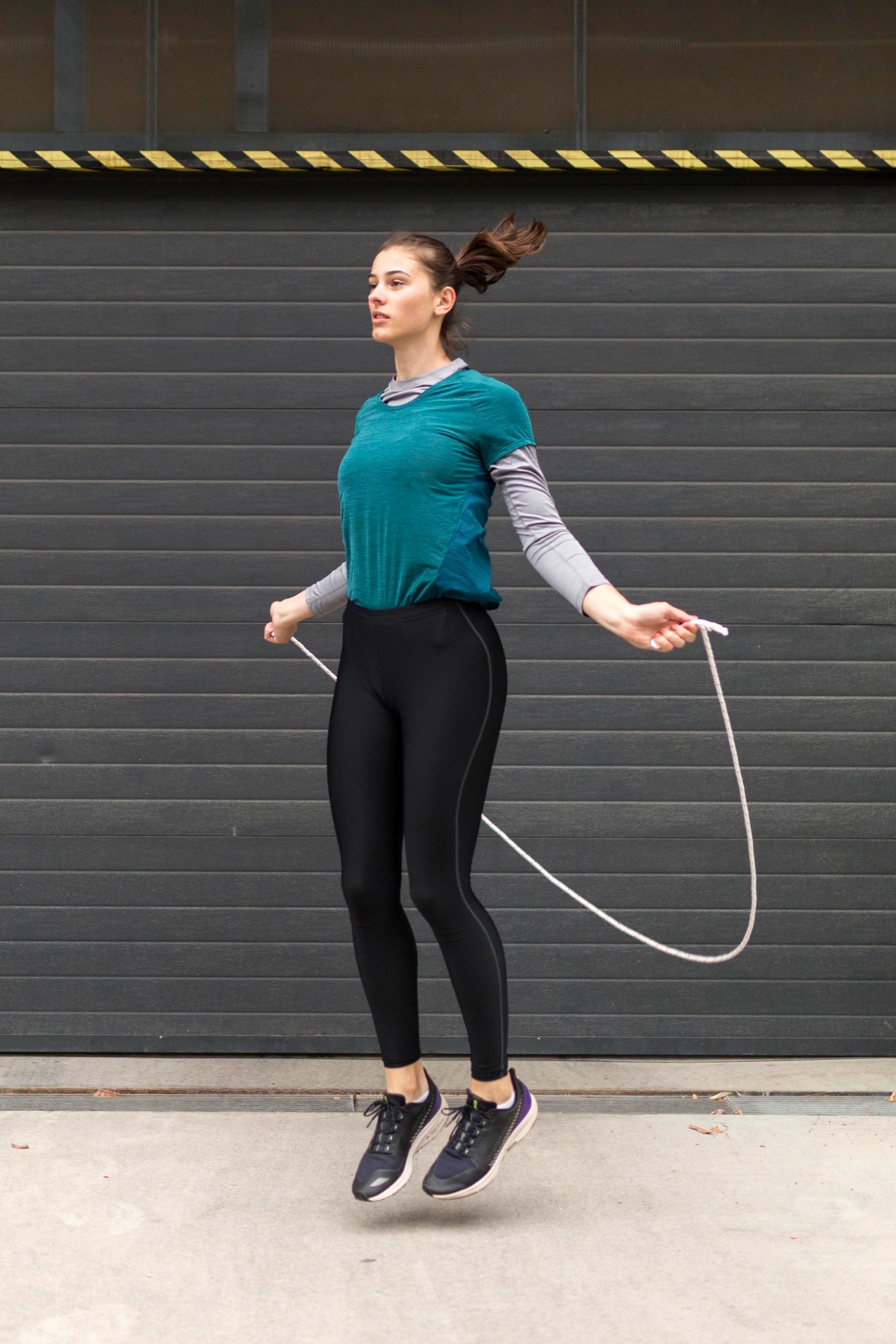Jump Rope Magic: Shed Pounds in Minutes a Day unveils the transformative power of jump rope workouts, an underrated champion in the realm of fitness. This comprehensive guide illuminates how mere minutes a day with the rope can not only torch calories but sculpt a leaner, more vibrant silhouette. Designed for the time-strapped individual, our focus transcends mere weight loss, aiming for profound, lasting fitness. Whether you’re embarking on your fitness journey or seeking to elevate your routine, jump rope offers a blend of simplicity and efficacy unmatched by conventional workouts.
Why Jump Rope for Home Cardio Workouts?
In the quest for optimal fitness, jump rope emerges as a king of cardio, unmatched in its blend of simplicity, affordability, and sheer effectiveness. Unlike bulky gym equipment or the monotony of treadmill runs, jump rope promises a heart-pumping workout that can be performed in the comfort of your home. Its brilliance lies in its ability to offer a high-intensity cardiovascular workout that not only burns calories at an astonishing rate but also enhances coordination, agility, and endurance. This segment delves into the science and allure behind jump rope, positioning it as a cornerstone of home cardio workouts.
Why Jump Rope for Home Cardio Workouts?
In the realm of fitness, jump rope stands out as a powerhouse for cardiovascular health and fat burning. This section dives deep into the why behind choosing jump rope as your go-to method for home cardio workouts, highlighting its unmatched efficiency and practicality.
Jump rope is more than just a fun childhood pastime; it’s a high-intensity cardiovascular workout that engages your whole body. Every jump demands coordination between your legs, arms, and core, making it an all-encompassing exercise. This coordination leads to significant cardiovascular benefits, enhancing heart health and increasing stamina. Furthermore, the constant movement and high-intensity nature of jump rope routines are exceptionally effective at burning calories. In fact, jumping rope can burn approximately 200 to 300 calories in just 15 minutes, depending on your intensity level and weight, making it one of the most efficient methods of fat burning available.
When compared to other forms of cardio, jump rope holds a distinct advantage in terms of efficiency and practicality. Running, cycling, and elliptical workouts are fantastic cardio options, but they often require more time to achieve similar calorie-burning effects. For instance, you might need to run at a moderate pace for over 30 minutes to burn the same number of calories that a 15-minute jump rope session can melt away.
Moreover, jump rope excels in practicality. It requires minimal equipment—a rope—and can be performed in a relatively small space. This makes it an ideal workout for those with limited room at home or for individuals who prefer to exercise while traveling. Unlike treadmills or stationary bikes, a jump rope can easily fit into a backpack or drawer, ensuring your workout routine never skips a beat, no matter where you are.

Additionally, jump rope workouts can be easily tailored to fit any fitness level. Beginners can start with basic jumps and gradually incorporate more challenging techniques like double unders or speed jumping as they progress. This adaptability not only prevents workouts from becoming monotonous but also allows for continuous improvement and challenge as your fitness level advances.
In summary, jump rope for home cardio workouts offers a unique combination of cardiovascular and fat-burning benefits with unmatched efficiency and practicality. Whether you’re pressed for time, space, or simply seeking a highly effective workout, jump rope routines deliver compelling results that few other cardio exercises can match. By incorporating jump rope into your fitness regimen, you’re not just choosing an exercise; you’re embracing a versatile, powerful tool for achieving your health and fitness goals.
Selecting the Right Jump Rope
Choosing the perfect jump rope is the first step towards a successful and enjoyable workout experience. The right rope can make a significant difference in the fluidity and efficiency of your routine. Here are key factors to consider when selecting a jump rope:
1. Length: The optimal length of your jump rope is crucial for comfort and efficiency. A simple method to find the ideal length is to step on the middle of the rope with one foot and pull the handles straight up. The tips of the handles should reach just under your armpits. For beginners, a slightly longer rope may allow for easier timing and slower jumps. As you become more proficient, you can opt for a shorter rope to increase speed and intensity.
2. Material: Jump ropes come in various materials, each offering distinct benefits. Leather ropes are durable and offer a traditional feel, but they can be heavier and more expensive. PVC or vinyl ropes are lightweight and fast, making them ideal for speed work and indoor use. Beaded ropes are durable and provide excellent feedback for rhythm, though they are typically slower and used for specific training styles or beginner practice. Steel cables coated in nylon are popular among advanced jumpers for their speed and are commonly used for competitive speed jumping and double unders.
3. Handle Type: The handle of your jump rope should be comfortable to hold, not too heavy or light, and provide a good grip. Handles come in different shapes and sizes, from short and straight to longer and ergonomic. Ball bearing handles are recommended for speed and efficiency, as they allow the rope to rotate smoothly and with less effort from the wrists. This can significantly reduce fatigue and increase the speed of the rope.
4. Adjustable Features: Many modern jump ropes come with adjustable length features, allowing you to fine-tune the rope to your preferred size. This is especially useful if you are between standard sizes or if multiple people of different heights will use the rope.
5. Weight: The weight of the rope matters, especially depending on your fitness goals. Heavier ropes provide a more intense workout, focusing on strength and endurance. Lighter ropes are best for speed and agility training. Beginners may benefit from starting with a medium-weight rope to feel the rope’s rotation better and establish rhythm.
When selecting your jump rope, consider your fitness goals, the space you’ll be using it in, and your experience level. The right jump rope not only enhances your workout experience but also helps in preventing injury, ensuring that every jump counts towards reaching your fitness objectives.
Basic Techniques and Getting Started
Jump rope is a fantastic way to enhance your fitness routine, but starting with the right technique is crucial for maximizing benefits while minimizing the risk of injury. Here’s a step-by-step guide to mastering basic jump rope techniques, tailored for beginners.

1. Master the Basic Jump:
- Positioning: Stand with your feet slightly apart, about hip-width. Hold the jump rope handles with a firm grip, elbows close to your sides.
- Rope Movement: Begin with the rope behind you. Use your wrists to swing the rope over your head and in front of you. Keep the movement smooth and controlled, avoiding excessive arm or shoulder movement.
- The Jump: As the rope approaches your feet, make a small, light jump off the ground, just high enough to clear the rope (about 1 inch off the ground). Land softly on the balls of your feet, knees slightly bent to absorb the impact.
2. Find Your Rhythm:
- Start with the rope behind you, and swing it to the front without jumping. Practice timing the jump as the rope comes down towards your feet.
- Once comfortable, incorporate the jump, focusing on maintaining a steady, even rhythm. Counting out loud or in your head can help (“One, two, one, two”).
3. Maintain Proper Form:
- Upper Body: Keep your torso upright and shoulders relaxed. Your elbows should be close to your sides, with wrists doing most of the work.
- Eyes Forward: Focus your gaze straight ahead to maintain balance.
- Breathing: Maintain regular, even breaths. Proper breathing helps prevent fatigue and improves endurance.
4. Practice Single Bounces:
- Initially, stick to single bounces for each rope swing. Avoid the temptation to do double jumps (bouncing twice under one swing), as this can disrupt your rhythm and increase the risk of tripping.
5. Gradual Progression:
- Begin with short sessions, aiming for consistency in your jumps and rhythm. As you become more comfortable, gradually increase your jumping time and decrease rest periods.
Importance of Proper Form to Prevent Injury:
Proper form is not just about efficiency; it’s crucial for injury prevention. Incorrect technique can lead to strain on the joints, particularly the knees and ankles, and can cause muscle soreness or more serious injuries over time. Paying attention to your body’s alignment and movement ensures that the impact of jumping is absorbed correctly and that you’re engaging the right muscles. Additionally, proper form allows you to jump rope more effectively, making your workouts more enjoyable and productive.
- Wrist Action: Use your wrists, not your arms, to rotate the rope. This reduces the strain on your shoulders and neck.
- Soft Landings: Always land softly on the balls of your feet to reduce the impact on your knees and ankles.
- Stay Light: Keep your jumps low to the ground. High jumps increase the risk of landing hard and can lead to injury.
Jumping rope is a skill that improves with practice. Starting with these basic techniques, you’ll build a solid foundation, ensuring your jump rope journey is both effective and safe. Remember, consistency is key. With patience and regular practice, you’ll soon be able to add more complex moves to your routine, all while enjoying the myriad benefits that jump rope has to offer.
Jump Rope Routines for Fat Loss
Jump rope is an exceptionally effective tool for burning fat and improving cardiovascular health. The key to maximizing fat loss is to structure your workout in a way that combines high intensity with intervals of rest or lower intensity—known as High-Intensity Interval Training (HIIT). Below are jump rope routines designed for beginner, intermediate, and advanced levels, each aimed at maximizing fat burning.
Beginner Routine
Start with a routine that focuses on building stamina and technique while gradually increasing intensity.
- Warm-Up: 5 minutes of gentle jogging or walking in place to get the blood flowing.
- Basic Jump: Start with 1 minute of basic jumps at a comfortable pace. Focus on form and finding your rhythm.
- Rest: Rest for 30 seconds. This is important to recover and prepare for the next set.
- Repeat: Repeat the jump-rest cycle for 10-15 minutes.
- Cool Down: End with 5 minutes of stretching to relax your muscles and prevent soreness.
As you become more comfortable, increase the jumping intervals by 15 seconds each week until you can perform continuous jumping for 3-5 minutes with shorter rest periods.

Intermediate Routine
For those who have mastered the basic jump and can maintain a steady rhythm, this routine introduces variety and increases intensity.
- Warm-Up: 5-10 minutes of dynamic stretching and light jogging.
- Alternating Feet: Jump rope by alternating your feet, as if running in place, for 2 minutes.
- Side Swings: Hold both handles in one hand and swing the rope at your side for 30 seconds as a light rest.
- High Knees: Perform high knees while jumping for 2 minutes to increase heart rate and burn more calories.
- Rest: Rest for 30 seconds.
- Double Unders: Try to perform double unders (the rope passes twice under your feet in one jump) for 1 minute. If too challenging, substitute with basic jumps but at a faster pace.
- Rest: Rest for 30 seconds.
- Repeat: Repeat the cycle for 20-30 minutes.
- Cool Down: Finish with 5-10 minutes of stretching.
Increase the duration of each segment gradually, and try to reduce rest times as your endurance improves.
Advanced Routine
This routine is designed for those who seek a highly challenging workout, incorporating speed, high intensity, and advanced jump rope techniques.
- Warm-Up: 10 minutes of dynamic stretching and jogging, including jump rope without the rope to mimic the motion.
- Double Unders: Perform double unders for 1 minute. Focus on form and speed.
- Freestyle: Use 2 minutes to incorporate freestyle jump rope moves (cross-overs, backward jumps, etc.). Push your creativity and agility.
- High-Speed Basic Jumps: Jump as fast as you can for 1 minute, focusing on speed rather than height.
- Rest: Rest for 20 seconds. Keep these rest intervals short and focused.
- Leg Work: Perform lunges or squats for 1 minute without the rope to mix in strength training.
- Repeat: Go through the entire cycle for 30-40 minutes, aiming for minimal rest between exercises.
- Cool Down: A thorough cool down with 10 minutes of stretching to ensure flexibility and reduce muscle tightness.
Structuring Your Workout for Maximum Fat Burning
- Incorporate HIIT: Alternating high-intensity jumping with short rest periods increases calorie burn both during and after the workout due to the afterburn effect (EPOC).
- Vary Your Routine: Keep your body guessing by changing up your routine regularly. This prevents plateaus in weight loss and keeps workouts engaging.
- Monitor Intensity: Use a heart rate monitor if possible to ensure you’re working within your optimal fat-burning zone.
- Stay Consistent: Consistency is more important than intensity for long-term fat loss. Aim for at least 3-5 jump rope sessions per week.
- Combine With Healthy Eating: No workout routine can outperform a bad diet. Pair your jump rope routine with balanced nutrition for the best fat loss results.
Jump rope routines are a dynamic and fun way to achieve and maintain fat loss. By starting at your current level and progressively increasing the challenge, you can enjoy continued improvement in both fitness and body composition.
Incorporating Jump Rope into Your Overall Fitness Routine
Jump rope is a versatile workout that complements various fitness modalities, from strength training to other forms of cardio. By integrating jump rope into your overall fitness routine, you enhance not only cardiovascular health but also muscle endurance, coordination, and fat loss. Here’s how to effectively combine jump rope with strength training and other cardio exercises, followed by a sample weekly workout plan.
Combining Jump Rope with Strength Training
1. Use Jump Rope as a Warm-Up: Jump rope is excellent for warming up your muscles and joints before lifting weights. A 5-10 minute session increases your heart rate and blood flow, preparing your body for the demands of strength training.
2. Incorporate Jump Rope Between Sets: Instead of resting passively between strength training sets, use jump rope for active recovery. This keeps your heart rate up, increases calorie burn, and improves your cardiovascular fitness.
3. End with Jump Rope: Finish your strength training sessions with a 10-15 minute jump rope workout. This can serve as a high-intensity interval training (HIIT) session, maximizing fat burning post-workout.
Combining Jump Rope with Other Cardio
1. Alternate Days: To prevent overtraining and ensure adequate recovery, alternate days between jump rope and other cardio activities like running, cycling, or swimming. This variety challenges different muscle groups and prevents boredom.
2. Create Cardio Circuits: Combine short bursts of jump rope with other high-intensity cardio exercises (e.g., burpees, high knees, mountain climbers) to form a circuit. This approach maximizes cardiovascular and muscular endurance.
3. Use Jump Rope for Active Rest Days: On days when you’re taking a break from intense workouts, a light jump rope session can serve as active recovery, keeping your muscles engaged without the strain of a full workout.
Sample Weekly Workout Plan
Monday: Strength Training + Jump Rope
- Warm-Up: 5 minutes of jump rope
- Strength Training: Upper body focus (45 minutes)
- Jump Rope: 10 minutes of HIIT
Tuesday: Cardio Focus
- Running, cycling, or swimming: 30-45 minutes at a moderate pace
Wednesday: Strength Training + Jump Rope
- Warm-Up: 5 minutes of jump rope
- Strength Training: Lower body focus (45 minutes)
- Jump Rope: 10 minutes, alternating feet jumps
Thursday: Active Rest or Yoga
Friday: Full Body Strength + Jump Rope
- Warm-Up: 5 minutes of jump rope
- Full Body Strength Training: Circuit style, 3 sets (45 minutes)
- Jump Rope: 15 minutes, including double unders and high-speed jumps
Saturday: Long Cardio Session
- Choose an activity different from Tuesday’s. Aim for 60 minutes of continuous activity at a moderate intensity.
Sunday: Rest
Tips for Success
- Listen to Your Body: Adjust the intensity and duration of workouts based on how you’re feeling. Rest if you’re experiencing signs of overtraining or fatigue.
- Stay Hydrated and Nourished: Proper nutrition and hydration support recovery and performance. Focus on a balanced diet rich in proteins, carbohydrates, and healthy fats.
- Track Your Progress: Keep a journal of your workouts, noting improvements in endurance, strength, and any jump rope skills you master.
Incorporating jump rope into your fitness routine offers a balanced approach to achieving your health and fitness goals. It not only adds variety and enjoyment to your workouts but also ensures a comprehensive fitness regimen that addresses strength, endurance, agility, and cardiovascular health.
Staying Motivated and Tracking Progress
Maintaining motivation and tracking progress are critical elements in any fitness journey. When it comes to jump rope workouts, setting realistic goals and keeping the routine fresh and challenging can significantly enhance your experience and results. Here’s how to stay motivated and monitor your achievements over time.
Setting Realistic Goals
1. Start Small: Begin with achievable goals that can be reached in a short amount of time. This could be as simple as jump roping for a full minute without stopping or completing a specific number of jumps. Small victories build confidence and motivation.
2. Set Specific, Measurable Goals: Instead of vague objectives like “get better at jump rope,” aim for clear, quantifiable targets—such as “perform 100 consecutive jumps without missing” or “complete a 20-minute jump rope session three times a week.”
3. Create Short and Long-Term Goals: While short-term goals provide immediate challenges and satisfactions, long-term goals keep you focused on the bigger picture. Whether it’s losing a certain amount of weight, mastering advanced jump rope tricks, or achieving a specific endurance level, having a mix of goals keeps you driven.
Keeping the Routine Fresh and Challenging
1. Vary Your Workouts: Incorporate different jump rope techniques, such as high knees, double unders, or criss-crosses, to challenge different muscle groups and improve coordination. Changing up your routine prevents boredom and plateaus.
2. Combine with Other Exercises: Mix jump rope sessions with strength training, yoga, or other sports you enjoy. This not only enhances your overall fitness but also keeps your workouts interesting and balanced.
3. Participate in Challenges: Many fitness communities and apps offer jump rope challenges, which can be a fun way to push yourself and stay engaged. Competing against yourself or others adds an extra layer of motivation.
Tracking Progress
1. Keep a Workout Journal: Documenting each workout, including what you did and how you felt, can provide insights into your progress and what works best for you. Over time, you’ll be able to see how much you’ve improved.
2. Use Fitness Apps: Many apps can track your jump rope sessions, monitor your heart rate, and even estimate calories burned. Seeing these metrics improve over time can be incredibly motivating.
3. Celebrate Milestones: Acknowledge when you hit your goals, no matter how small. Celebrating milestones reinforces positive behavior and keeps you motivated to set and reach new targets.
4. Share Your Journey: Whether it’s with friends, family, or an online community, sharing your progress can provide a sense of accountability and support. Feedback and encouragement from others can boost your motivation.
5. Reflect on Your Progress: Regularly look back on where you started and how far you’ve come. Reflecting on your journey and the obstacles you’ve overcome can be a powerful motivator to keep going.
Staying motivated and tracking progress in your jump rope routine ensures that you continue to move forward and see the results of your hard work. By setting realistic goals, keeping your workouts varied and challenging, and monitoring your achievements, you can maintain a high level of motivation and commitment to your fitness journey.
Nutrition and Hydration Tips for Maximum Results
Optimizing your jump rope routine for fat loss and performance isn’t just about the workout itself; your diet and hydration play a crucial role. Adhering to basic nutritional guidelines and ensuring proper hydration can significantly enhance your results. Here’s how to fuel your body for maximum efficiency and recovery.
Basic Nutritional Guidelines to Support Fat Loss
1. Focus on Whole Foods: Build your diet around whole, nutrient-dense foods. These include lean proteins (chicken, fish, legumes), complex carbohydrates (whole grains, sweet potatoes), healthy fats (avocado, nuts, olive oil), and a variety of fruits and vegetables. Whole foods provide the energy and nutrients your body needs for performance and recovery.
2. Monitor Portion Sizes: Consuming more calories than you burn leads to weight gain. Even healthy foods can contribute to weight gain if eaten in excessive amounts. Use hand portions to estimate serving sizes, and listen to your body’s hunger and fullness cues.
3. Prioritize Protein: Protein is essential for muscle repair and growth, especially important if you’re combining jump rope with strength training. Aim to include a source of protein in every meal and snack.
4. Time Your Carbs: While carbs are your body’s primary energy source, timing them around your workouts can help optimize performance and recovery. Eating complex carbs a few hours before your workout can fuel your session, while including them in your post-workout meal helps with recovery.
5. Reduce Processed Foods and Sugary Drinks: Processed foods and sugary drinks can sabotage fat loss efforts. They’re often high in calories but low in nutrients, leading to energy crashes and cravings. Focus on hydrating with water, and choose whole foods for snacks and meals.
Importance of Hydration
1. Hydration for Performance: Water is essential for optimal physical performance. Dehydration can lead to fatigue, reduced endurance, and a higher risk of heat-related illnesses. Drink water throughout the day and especially before, during, and after your workouts.
2. How Much to Drink: General guidelines suggest drinking at least 8-10 glasses of water a day, but individual needs can vary based on factors like weight, climate, and exercise intensity. A good indicator of hydration is the color of your urine—it should be light yellow.
3. Hydrating Foods: In addition to drinking water, you can consume hydrating foods. Many fruits and vegetables, such as watermelon, cucumbers, and oranges, are high in water content and can help keep you hydrated.
4. Electrolytes Are Essential: For longer or more intense workouts, replacing electrolytes (sodium, potassium, magnesium) is important. Electrolyte replacement can come from sports drinks (choose low-sugar options), or natural sources like bananas (potassium) and nuts (magnesium).
Proper nutrition and hydration can significantly impact your ability to perform and recover from jump rope workouts. By focusing on whole foods, managing portion sizes, timing your nutrient intake, and staying hydrated, you can support your fat loss goals and enhance your overall health and fitness. Remember, the key to dietary success is consistency and balance, ensuring that your nutrition plan is sustainable and enjoyable.
Safety Tips and Avoiding Common Mistakes
Jump rope is a dynamic and effective workout tool, but like any physical activity, it comes with a risk of injury if not performed correctly. Recognizing common mistakes and following safety tips can help you avoid injuries and get the most out of your jump rope sessions. Here’s how to stay safe and efficient:
Common Jump Rope Mistakes and How to Avoid Them
1. Using the Wrong Rope Length: A rope that’s too long or too short can disrupt your rhythm and increase the risk of tripping. Fix: Adjust your rope so that when you step on its center, the handles reach just under your armpits.
2. Jumping Too High: High jumps expend unnecessary energy and increase impact on landing, which can lead to joint stress. Fix: Keep jumps low, around 1-2 inches off the ground, just enough to clear the rope.
3. Poor Posture: Bending forward or backward can strain your back and neck. Fix: Maintain an upright posture with a slight bend in your knees to absorb shock, and engage your core throughout the workout.
4. Overusing Arms and Shoulders: Using your arms and shoulders to swing the rope can lead to fatigue and strain. Fix: Use your wrists to rotate the rope and keep your elbows close to your sides.
5. Landing Hard: Stomping or landing heavily puts unnecessary stress on your knees and ankles. Fix: Land softly on the balls of your feet and bend your knees slightly to absorb impact.
Tips for Preventing Injuries
1. Warm-Up Properly: A thorough warm-up increases blood flow to your muscles and prepares your body for exercise, reducing the risk of injury. Spend 5-10 minutes on light cardio and dynamic stretches.
2. Wear Appropriate Footwear: Supportive sneakers that offer good cushioning and stability can help protect your feet and joints from the impact of jumping. Avoid worn-out or inappropriate shoes.
3. Choose the Right Surface: Jumping on a hard surface increases impact on your joints. Opt for a wooden floor, an exercise mat, or a surface designed to absorb shock. Avoid concrete or asphalt if possible.
4. Gradually Increase Intensity: If you’re new to jump rope, start slowly and gradually build up your speed and duration. This gives your body time to adapt and can prevent overuse injuries.
5. Listen to Your Body: Pay attention to any signs of discomfort or fatigue. If you experience pain, stop your workout and rest. Pushing through pain can lead to serious injuries.
6. Practice Good Form: Focus on maintaining proper form throughout your workout. If you find your form slipping, take a break or end your session early to prevent injury.
7. Stay Hydrated: Dehydration can affect your concentration and physical performance, increasing the risk of accidents and injuries. Drink water before, during, and after your workout.
8. Rest and Recover: Adequate rest is essential for recovery and injury prevention. Ensure you’re getting enough sleep and include rest days in your workout schedule to allow your body to recover.
By being mindful of these common mistakes and following the safety tips provided, you can enjoy a productive and injury-free jump rope experience. Remember, consistency and proper technique are key to making progress and avoiding setbacks due to injury.
Conclusion
Jump rope is an incredibly efficient, versatile, and effective exercise that offers a myriad of benefits for those looking to enhance their fitness regime. It stands out for its simplicity, requiring just a rope and a small space to start a workout that can significantly improve cardiovascular health, aid in fat loss, enhance coordination, increase stamina, and tone muscles. The adaptability of jump rope routines allows for a range of intensities, making it suitable for all fitness levels—from beginners to advanced athletes.
Recap of Key Benefits:
- Boosts Cardiovascular Health: Regular jump rope sessions increase heart rate, improving heart and lung health and endurance over time.
- Promotes Fat Loss: High-intensity jump rope workouts are excellent for burning calories quickly and efficiently, aiding in fat loss and muscle definition.
- Improves Coordination and Agility: The rhythmic nature of jump roping enhances hand-eye coordination, balance, and agility, which are beneficial for all physical activities.
- Versatile and Convenient: Jump rope is a low-cost, portable exercise that can be done virtually anywhere, fitting easily into any lifestyle or schedule.
- Strengthens Muscles: It engages multiple muscle groups, from the legs to the core and upper body, providing a full-body workout.
Encouragement to Start:
If you’ve been contemplating adding jump rope to your fitness routine, there’s no better time to start than now. With minimal equipment and space required, jump rope offers a convenient and effective way to achieve your fitness goals. Whether your aim is to lose weight, improve your cardiovascular health, or simply add variety to your workouts, jump rope can be tailored to meet your needs.
Consistency Is Key:
As with any fitness endeavor, consistency is crucial. Regular practice and dedication are what transform short-term gains into long-lasting health benefits. Setting realistic goals, tracking progress, and varying your routines can help keep you motivated and engaged. Remember, it’s not about perfection but progress. Even on days when motivation wanes, a short jump rope session is better than none. Over time, you’ll not only see improvements in your physical health but also in your mental well-being and overall quality of life.
Incorporating jump rope into your fitness regime is more than just a way to stay in shape; it’s a pathway to a healthier, more vibrant life. With each jump, you’re building a stronger, more resilient body and mind. So grab your rope, and let’s start jumping our way to peak fitness. Remember, the journey of a thousand miles begins with a single jump. Stay consistent, stay motivated, and enjoy the incredible journey that jump rope fitness brings.


